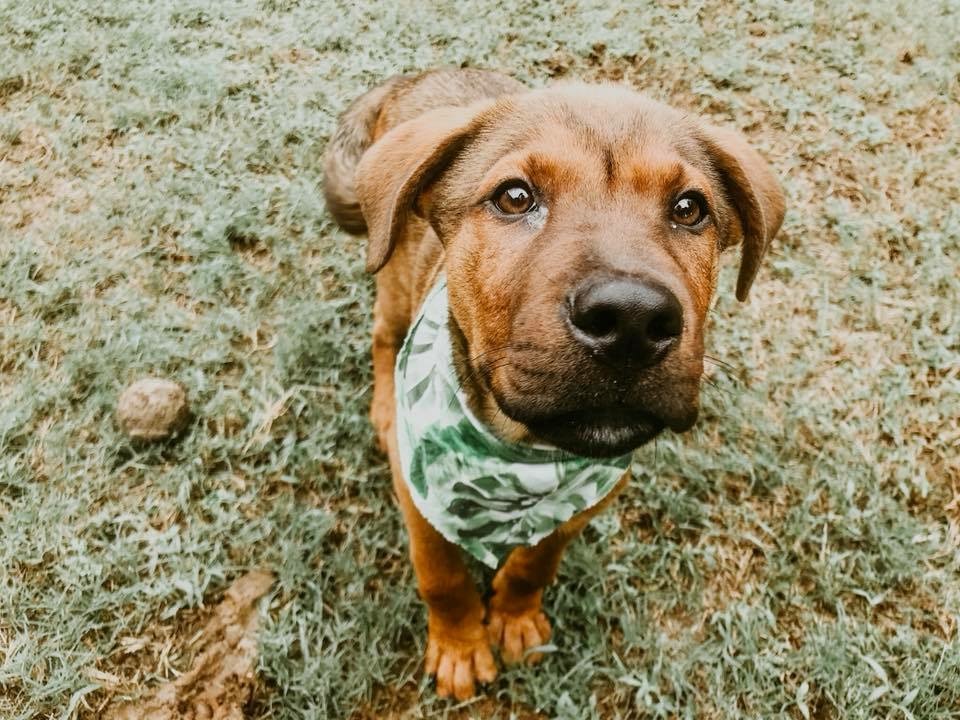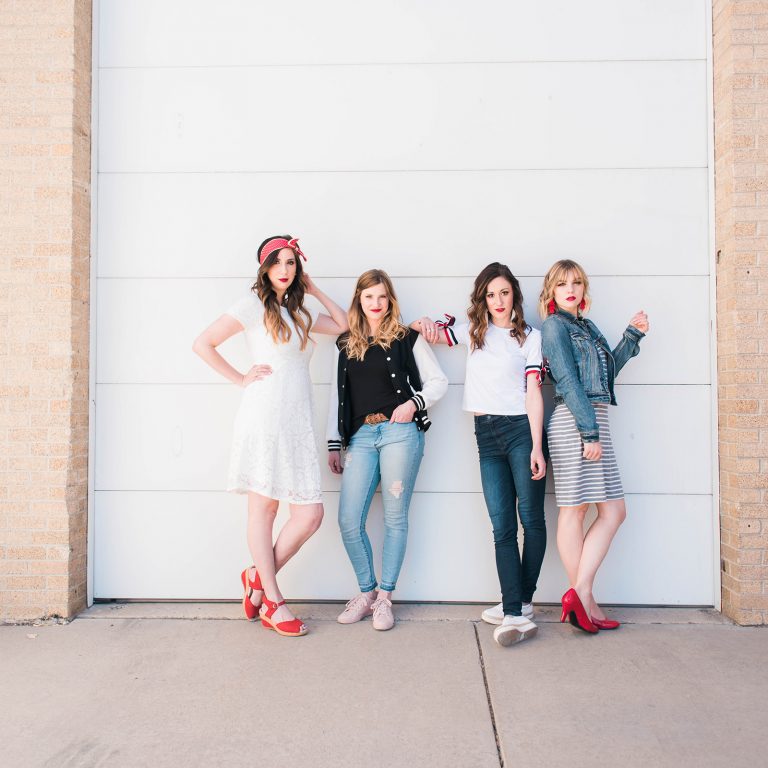Happy FRI-YAY!!!! As most of you know at this point – my hubby and I added yet another furry member to our family: ARCHER! He is a really cute 13-week old puppy we adopted from a foster program down in Arkansas. Believe it or not – someone threw this sweet angel out of the back of a moving car and just dumped him on the side of the road. While the thought of someone doing that to any living this makes my blood actually boil – their loss is our gain because we are in puppy LOVE. He’s so fun and busy and such a sweetie. We love taking him everywhere we go and it’s been such a joy learning the ropes of having a pup. SO in honor of adopting our first dog AND the fact that it is National Dog Adoption Month (how perfect, right?!): I’m sharing the best new puppy guide for those of you who have tiny pups in your life, too! Let’s dive into this.
The *BEST* New Puppy Guide For First Time Dog Owners

I’ve had dogs my whole life – Archer just happens to be my first one with my hubby and not *technically* owned by my parents. It’s a lot different having all of this responsibility to care for this sweet little thing all on your own – and from experience: puppies are WAY WAY WAY harder than kittens. I love my kitties and they are the actual best and so much easier to train and own than a pup. I could pretty much give them the run of the house once they were full litter box trained and they are pretty well behaved for the most part. Archer is still potty training but he’s also chewing everything right now. He definitely is not trusted by himself yet. #oof Anyways, let’s dive into this easy guide to making life with your new puppy more fun and less stressful.
One: Get all records of vaccinations, surgeries and first exam if available.
We adopted Archer from a friend of ours who fosters dogs in Arkansas and she made sure we had his records from his first vet visit, all vaccination papers and the medicine he was on for a mild skin infection. They kept us up-to-date on which shots he received and when as well as when his last flea + tick prevention was administered so we could keep on top of that as well.
Most reputable shelters and foster programs will have this available (and of course, breeders will, too). Just make sure you get all relevant information so you aren’t surprised by an illness or hereditary disease at their first vet appointment with you.
Two: Determine the best feeding schedule for your puppy.
Start by feeding them the food they were receiving at the shelter or breeders and slowly mix in new food if you plan on changing it (to limit diarrhea and vomiting). Some – most – puppies are scarfers and so it’s best to put them on a regular feeding schedule. This will help them potty train as well, because you’ll know when to take them outside. Other puppies are grazers (like Archer) so I tend to let him eat when he’s hungry and just leave his dish out until he finishes it. The vet confirmed that this was ok, and not to try to force him to eat if he doesn’t want, too. You want them to build a good relationship with food and eating time.
Three: Do not overestimate their bladder.
They have teeny tiny little bladders and they can’t hold their pee very long. While they are potty training, take them out to go pee/poop every 20-30 minutes (less if it’s a smaller dog). This should be the first thing you do when they get up in the morning, the last thing you do before bed, after a rousing play session, after a nap and about half and hour after they have eaten or had some water. You will continue to do this until they are fully potty trained. While they are really little, you may even need to get up half way through the night so they don’t go potty while you sleep.

Four: Crate train your pup.
There are some mixed emotions about crate training but Adam and I, my parents, several friends, our veterinarian and our dog trainer all agree: crate training is one of the best things you can do for your pup. It makes it so much easier to potty train, put them to bed, put them up when company is over and just overall have a safe space to retreat to if they need to take a minute. Archer loves his crate and will often go in there on his own to take naps. My parents dog does the same thing. Plus, I feel better knowing he isn’t destroying my house while I am gone, too. The cats also get a little bit of a reprieve when he’s kenneled at night and overall makes the transition much easier for everyone.
Five: Socialization is key.
Your pup is learning SO MUCH right now about how he or she should behave in the world. Introduce them to other dogs, cats, children and a variety of people. Say hi to the mailman, walk through Home Depot and pet smart, bring treats for strangers to give him while you are out. Encourage people to pet them nicely. It’s important that puppy learns that people are nice and not to be afraid of them.
Six: Get him into training classes ASAP.
Starting between 12-16 weeks, most training classes will start taking new puppies. At this point, they’ve had all their vaccinations and they are ready to learn how to behave. There are so many options available to you when it comes to training your pup – you can opt for once or twice a week lessons with an experienced trainer, a send-away camp to full immerse them in training, an at-home lesson with a trainer, or training yourself via youtube. 😉 We are currently weighing all the options for Archer right now and will be doing a full review on the option we decide to go with in a few months.
Seven: GIVE THEM ALL THE LOVE.
This one is just for kicks and giggles but….love that puppy! They are so precious and sweet at this age – they are so dependent on you and so helpless and full of mischief. Just like kids, they are looking for structure and attention and love. It’s up to you to provide a loving home with everything they need!

PIN THIS FOR LATER:

I hope this short and sweet puppy guide helps you with your new household addition. I know it’s almost NEVER a completely smooth transition. That is totally normal. Get comfortable with your veterinarian – you can call them if you need them. I really love the vet we have for Archer. She is amazing and really great with our sweet pup. I trust her opinion and knowledge and know that I can ask questions any time I need.

Do you have a puppy? What are your TOP tips for other new doggo owners?! We need all the help we can get. 😉



















Omg, He is SOOOO adorable!!! What a cutie pie, and this is a great guide to owning a new pup!!
Kileen
cute & little
I just wanna boop that cute little nose! This is such a helpful guide. I know my fiancé and I want a dog in the future, so we’ll have to turn back to this post when we truly make that decision to get another furbaby!
Your new pup is so adorable!
Ohmygosh what a cutie!!! I would love a pupper but my apartment makes you pay a $50 pet rent every month if you have one and DC rent is already quite expensive.
OMG I can hardly contain myself with the puppy picture overload. DEAD rn, and such a cute post! xo, Suzanne http://www.suzannespiegoski.com
okay archer is such a cutie!! i did the puppy battle this year too – and still have some potty oopsies in the house when she feels like being a brat 🙂
Awwww I love the name Archer!! He is so sweet and bless you all for taking him on from a rescue! If I was going to add to your list, I’d strongly strongly suggest signing new pups up for insurance before taking them to their first appointment before pre-existing issues are found. Plus insurance is usually cheaper (and more useful) the younger you sign them up. I will never own another pet without insuring them….it’s invaluable if/when the unexpected happens and truly changes the way you handle medical decisions. Our senior cat isn’t insured bc he was too old for coverage by the time I wised up to insurance, and even though we say we’ll do anything for him, we inevitably have to make strategic decisions to keep costs down bc of course he’s developed a whole host of health issues over the last few years so he makes me regret every single day that I didn’t get him insured (like yesterday when I was quoted $1200 for a CT scan =\).
He’s so cute!
I like the tips – let me add one more: think about what your plan for an accident on the carpet is BEFORE it happens. Because it WILL happen. This blog is helpful as well (https://www.elchemdry.com/pet-stain-on-the-carpet-tips/). You’ll do yourself a favor by having all of the stuff necessary for clean up on hand and ready to go for when it happens.
That bottom pic is the greatest! So damn cute!